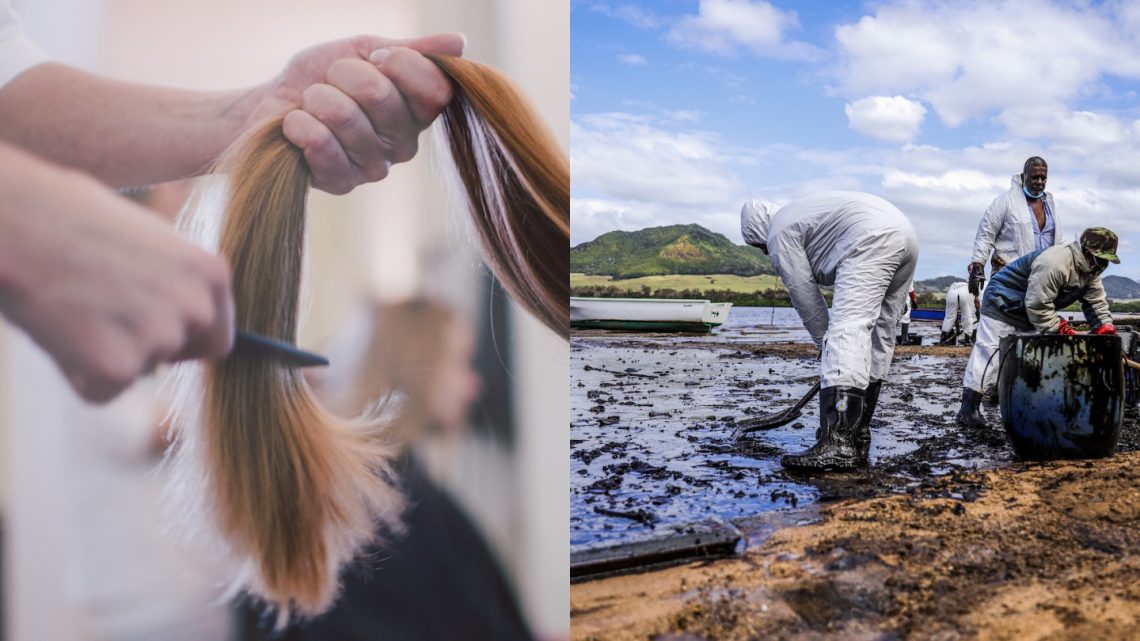
Human Hair is Being Collected to Soak Up an Oil Spill in Mauritius
August 26, 2020Australian hairdressers have collected more than 10 tonnes of human hair to be used in the cleanup of a massive oil spill off the coast of Mauritius.
The shipwrecked MV Wakashio, an empty Japanese bulk carrier that ran aground on a reef off the coast of the island nation last month, has already leaked close to 4,000 tonnes of fuel oil—three quarters of its tank—into the pristine waters of the Indian Ocean. Much of that has since washed ashore in the Ile aux Aigrettes nature reserve, a low-lying islet just south of Mauritius’ mainland that is home to the last remnants of the country’s dry coastal forest and the endangered species that depend on it.
It is the country's largest-ever marine ecological disaster. And now Sydney salons are collecting huge amounts of hair clippings in a bid to help with the relief effort.
A week before the Mauritius oil spill began, the University of Technology Sydney (UTS) published scientific research indicating that human hair and dog fur were both remarkably effective at soaking up oil. In the spirit of those findings, Australian-based NGO Sustainable Salons—a resource recovery service aimed at fixing the world’s salon waste problem by recycling hair, foil and chemicals—is sourcing offcuts from hairdressers around Australia and New Zealand with the aim of shipping it off to Mauritius.
To date, more than 28 tonnes worth of human hair has being stockpiled at Sustainable Salons’ Sydney depot, where the clippings are stuffed into large stockings to create sausage-shaped “hair booms”. Once negotiations with the Mauritian Government are finalised, these booms are to be sent overseas to help mop up the mess.
Oceanic oil spills are usually cleaned up using floating barriers that corral and skim up pollutants, as well as dispersants and chemical emulsifiers that break up the oil and help it disperse into the water. But hair booms are being heralded as an organic, and potentially far more effective, alternative.
The UTS study found that “Booms made of recycled human hair waste were significantly better at absorbing crude oil from simulated oceanic spills compared to mainstream commercial sorbents including polypropylene, recycled cellulose, and cotton by-products.”
Megan Murray, a lead author of the study, further explained that “we think the external cuticle structures of hair combined with the fine fibers and high surface area make it a very efficient material at holding crude oil.”
“There's very good evidence that this is an effective and affordable method for cleaning up spilled oil on ocean surfaces as well as hard land surfaces,” she told VICE News over email, and described the findings of the study as “very exciting”.
It’s understood that a single hair boom can soak up to four litres of crude oil—meaning Mauritius would need about one million booms to soak up the entirety of the Wakashio spill.
Paul Frasca, a co-founder of Sustainable Salons, has described the collection effort as “international hair boom aid”, and insisted in a promotional video that the organisation is committed to keeping a supply of hair on hand in case of an oil spill off the coastlines of Australia or New Zealand.
“What we’re trying to do is make contact with the right organisations in Mauritius right now so we can make sure we got a streamline of our booms getting over to their island to help with the spill,” he said. “We are working hard right now … to try to get our booms over there as soon as possible.”
While hair has been used in “small but noteworthy ways” to clean up major oil spills in the past—including the 2007 Cosco Busan disaster off the coast of California and the 2010 Deepwater Horizon disaster in the Gulf of Mexico—Murray hopes its newly-proven efficacy at absorbing crude oil could help pave the way for more environmentally friendly cleanup efforts in the future.
“Hair is as good as polypropylene—one of the biggest sorbent materials we use at the moment, which doesn't degrade very well at all in landfill—for most kinds of oil spills,” she said. “Everything we can do to reduce our reliance on non-sustainable materials, even in disaster management, is a great step forward for global sustainability.”
Follow Gavin on Twitter


